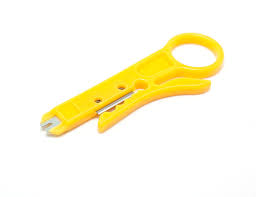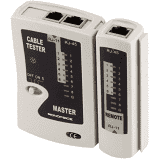Anyone notice those silver screws bolting the supposed patch panel face first to the wall?
I don't think that patch panel is what you think it is.
It looks like something that splices together pairs of ethernet cables. Not something that provides rj-45 outlets (a patch panel). These are more common in telephony where the telephone company comes in on the bottom, and your outlets go out on the top. It's not really used much at all for ethernet networking.
BUT you can salvage the situation.
First, make sure it's not actually a patch panel:
 bolted uselessly face first to the wall by taking it off the wall and checking for rj45 ports.
bolted uselessly face first to the wall by taking it off the wall and checking for rj45 ports.
Then you can either buy an actual patch panel and a pushdown tool, and transfer the wires to it. (Remember to trim each wire 1 inch first, untwist, and push down a fresh spot on each conductor. Do not take the easy way out and try to reuse where it's already been bitten. The push-downs depend on the malleability of copper to make a good connection by deforming it during the push)
Or you can crimp them all with rj45 heads. so called home-runs. This is less professional but works just fine in a house. I've 'done the I.T.' for 20 years and used home runs in my home built newly for me a couple years ago. The cables are long enough I could turn it into a patch panel later, but I haven't felt the need.
If you want to go patch panel route you will need to buy the patch panel ($30-ish) and a punch down tool. The cheap kind ($2-3-ish) will do.

And buy short ethernet cables for as many ports as you want to use. $2-3 each
If you want to go home run route, you will need a bag of crimp heads:

($10-40 depending on store) and a crimper tool ($20 for a cheap one, and your first one should be cheap if you're not planning to make a career out of this).

Either way, you should get or borrow a proper tester. I made my last crimping mistake in 2017, but I still test every time. If you've never done crimping before. you should expect every crimp to be faulty the first 5-10 times, then about 50% success for the fifty after that, then decreasing to 5% error rate at 1000 crimps. and to 0.5% a year later, and about halves each subsequent year. I have trained a dozen or so newbies to crimp ethernet on a daily basis.
It a tester looks like or resembles this:
 it's trash and you may as well "just test with a laptop" and pretend you don't know that a partially bad cable can still pass data but will negotiate to a lower speed/duplex that will result in packet loss when you're using it heavily.
it's trash and you may as well "just test with a laptop" and pretend you don't know that a partially bad cable can still pass data but will negotiate to a lower speed/duplex that will result in packet loss when you're using it heavily.
I recommend the Real World Certifier from Byte Brothers:
 This certifier will 'grade' the cable using dozens of RF metrics. There are other certifiers, from Fluke for instance, that cost between 10 and 180 thousand and are more precise. But the RWC is good-enough to be useful at a price that's reasonable for DIY.
This certifier will 'grade' the cable using dozens of RF metrics. There are other certifiers, from Fluke for instance, that cost between 10 and 180 thousand and are more precise. But the RWC is good-enough to be useful at a price that's reasonable for DIY.
Basically tester=junk. Certifier=good. But I can see that $300+ is a bit much to swallow on a project as small as yours so maybe skip testing and hope for the best.
Any 'tester' that gives you just a single good / not good is junk.
The RWC also has a tracer/toner function that can track down what cable is what without even crimping both ends.
Though I do note what looks like numbered labels in your photo. Those might correspond with a label on or in the jacks in your rooms. Try popping their cover off and looking inside for a matching label.
And if you want a cleaner look for your bundle of cables in the garage, you should try a "brush cable pass through":
 I wouldn't bother in a garage or basement. In a finished room if it's in a visible location, sure. Though a patch panel doesn't belong in a finished room in a visible location..... Not in a house anyway.
I wouldn't bother in a garage or basement. In a finished room if it's in a visible location, sure. Though a patch panel doesn't belong in a finished room in a visible location..... Not in a house anyway.
Once all your 'drops' are crimped and tested, it's time to get a 'network switch' for the garage. In this day and age, I'd recommend nothing less than a gigabit PoE switch. It can provide power to IP cams and ip telephones without bulky external power 'injectors'. I even have entire DVRs that are powered off PoE in my house. You can choose from hundreds of choices on amazon/newegg. Ones with only a few PoE ports would be good as well. Most anything would work in residential.
Then either move the arris router to the garage and link it to the switch (preferred). Or treat the cable from the garage to it as the switch's 'uplink' to the arris, and leave the arris where it is.











